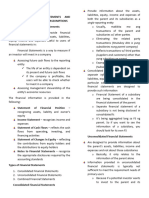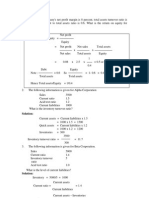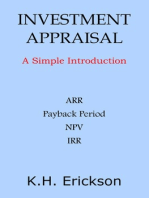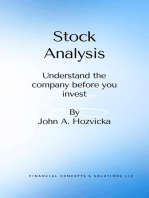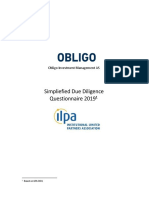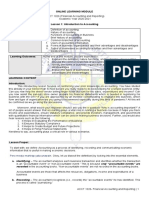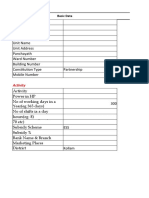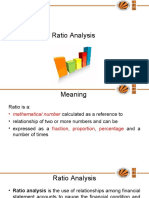Fin 260
Uploaded by
nazrsawyerFin 260
Uploaded by
nazrsawyerFINANCIAL RATES FOR MAJU JAYA SDN BHD ON THE YEAR 1997 Liquidity Ratio Current ratio = Current
assets / Current liabilities = 156 300 / 73 000 = 2.14x Quick ratio = Current assets Inventory Current liabilities = 156 300 93 000 73 000 = 0.87x Activity Ratio Inventory turnover = Cost of good sold / Inventories = 500 000 / 93 000 = 5.37x Average collection period = Account debtors / Annual Sales = 38 000 / 700 000 x 360 = 19.54 days Fixed asset turnover = Sales / Net Fixed Sales = 700 000 / 290 000 = 2.14x Total asset turnover = Sales / Total Assets = 700 000 / 446 300 = 1.57x
NAZRI@2011
Leverage / Gearing Ratio Debt ratio = Total Liabilities / Total Assets = 223000 / 446 300 = 49.97 % Debt-Equity Ratio = Long-Term debt / Shareholders Equity = 150 000 / 223 000 = 67.26% Times interest earned = Net profit before interest and taxes (NPBIT) / Interest Payment = [ Gross profit - ( Op. Expenses + interest + depreciation ) ] Interest payment = [ 200000 - ( 50000 + 10000 + 30000 ) ] / 10 000 = 200 000 90 000 / 10 000 = 110000 / 10 000 = 11x Profitability Ratio Gross profit margin = Sales - Cost of goods sold / Sales = Gross profit / Sales = 200 000 / 700 000 = 28.57 % Return on investment = Net profit after interest and tax (NPAIT) / Total Asset = (NPBIT - 24.64%) / 446 300 = 110000 - 24.64% / 446 300 = 6.07 % Return on equity = NPAIT / Shareholders Equity = 82 896 / 223 300 = 37.12 % Operating profit margin = Operating profit (NPBIT) / Sales = 110 000 / 700 000 = 15.71 % Net profit margin = Net Income / Net Sales = 82 900 / 700 000 = 11.84 %
NAZRI@2011
COMMENT ON THE FIRMS ABOUT THE RELEVANT FINANCIAL RATIOS Liquidity ratio Current ratio Quick ratio 1997 2.14x 0.87x INDUSTRY AVERAGE 1.80x 0.90x
Based on the liquidity ratio result, we can compare between company operation on 1997 and industry average that the current ratio on 1997 is better than the industry average. It means Maju Jaya Sdn. Bhd. have a ability as the firm to pay off it's debt with it's current assets. The concept of quick ratio has said that the ability of the firm to pay off it's current obligation with it's most liquid assets. Inventories is a current but to convert it to cash might be difficult as inventories consists of raw material, work in progress and finished goods. So, the quick ratio of Maju Jaya Sdn. Bhd. is equal that the change in the ratio is not that much. Activity ratio Inventory turnover Average col. period Fixed assets turnover Total assets turnover 1997 5.37x 19.54 days 2.41x 1.57x INDUSTRY AVERAGE 7.00x 20 days -
From the activity ratio result, we can see the inventory turnover by industry average is better than operation on 1997. The concepts of inventory turnover is that how the firm uses it's available assets effectively and it's also indicate how well firm's convert their receivable to cash. As a simple answer, Maju Jaya Sdn. Bhd. has a very good sale during that accounting period because the higher level of inventory turnover is a better for the firm's. About the average collection period (ACP), the concept is that it will help the firm to determine if its present credit collection is effective. If the credit period given to its customers is only 30 days but the average collection shows more days, this will indicate that the firm's need to do an evaluation of their credit policy and collection policy. So, industry average is better than operation on 1997 for Maju Jaya Sdn. Bhd. But they have to make improvement for their credit and collection policy because the shortest days is the most better for the firm's. The fixed assets turnover of Maju Jaya Sdn. Bhd. is not much better because it's too low. So, the best value level is commonly at 4x until 6x and over than that. As a simple
NAZRI@2011
answered, the fixed assets of Maju Jaya Sdn. Bhd. are not well to generate their sales. Same like a fixed assets turnover, the total assets turnover of Maju Jaya Sdn. Bhd.is also too low. Its mean that the total assets turnover of Maju Jaya Sdn. Bhd. is still not well to generate their sales. The conclusion is commonly the changes in the quick ratio is not that much. Leverage/ Gearing Ratio Debt ratio Debt-equity ratio Times interest earned 1997 49.97 % 67.26 % 11x INDUSTRY AVERAGE 50 % 10x
The concept of debt ratio (DR) is that the ratio will measure the amount or percentage of total asset actually being finance through debt by the firm. It means that how much the firm is using borrowed funds for their operation. In this case, we can see the debt ratio of Maju Jaya Sdn. Bhd. indicate the higher the amount of debt, the higher the ratio will be. Basically, the amount of debt ratio is not more over 40% is better for the firm's. But what can we determined from the debt ratio resulted that both on 1997 and industry average of Maju Jaya Sdn. Bhd. is not much better because the value was over more than 40%. So, the conclusion has made that Maju Jaya Sdn. Bhd. borrows more money from outside. Based on the debt-equity ratio (DER), this concept explained that the ratio would show the relationship between long-term debt and net worth or equity. This ratio will help to identify the pattern of cash flow that the firm has. As a result, the debt-equity ratio of Maju Jaya Sdn.Bhd. is also not much better because the low value is good for the firm's. The times interest earned (NPBIT) will measure that the ability of the firm in paying it's fixed obligation on interest. The higher value of the ratio will indicate that the firm is in the position to continue making payment for it's obligation. So, when we looked at the NPBIT of Maju Jaya Sdn. Bhd., the industry average is better than operation on 1997. That is means the low of times interest is better for the firm's.
NAZRI@2011
Profitability Ratio Gross profit margin Return on investment Return on equity Op. profit margin Net profit margin 1997 28.57 % 6.07 % 37.12 % 15.71 % 11.84 % INDUSTRY AVERAGE 8.40 % 10.75 %
From the gross profit margin resulted, we can expect that gross profit of Maju Jaya Sdn. Bhd. is balance to cover their operating expenses, prepaid, debt, and so on. But if the gross margin is higher, it's better for Maju Jaya Sdn. Bhd. because we don't know the net value of profit after sales (Sales GP). So, calculated of gross profit margin is just to show the remaining money the firm will have it has to pay for its goods (supply). The return on investment (return on total assets) for Maju Jaya Sdn. Bhd. is better in industry average than operation on 1997. But the higher the ratio is better for the firm. So, it is indicate the effectiveness of the firm to generate profit with all its available assets. The return on equity of Maju Jaya Sdn. Bhd. is also better. It is indicate that the return earned for each dollar of the investment made towards the firm's. About operating profit margin of Maju Jaya Sdn. Bhd., they have a stability ratio. That's mean the profit the company will get for each dollar invested. At last, net profit margin of Maju Jaya Sdn. Bhd. is better on 1997 compare with industry average. So, that's mean the degree of sales dollar that will remain after all expenses has been deducted. Based on all of financial ratio, the conclusion for Maju Jaya Sdn. Bhd. need to controlled the amount of debt so that the firm will not have to high obligation.
NAZRI@2011
THE SOURCES & USES OF FUNDS STATEMENT FOR THE YEAR ENDING 31ST DECEMBER 1997 Sources and Uses of Funds Year Ending 31/12/1997 ( in RM '000 ) SOURCES Account debtors Prepaid rent Account creditors Common stock 4 0.1 7 51.1 Plant and equipment Notes payable Accruals Long-term debt Cash Marketable securities Inventory USES 4 5 1 10 1 0.2 43 62.2
62.2
NAZRI@2011
NOTE
The assessment reported about financial performance of Maju Jaya Sdn. Bhd. The instructor for this subject, Fundamentals Of Finance (FIN 260) was Mr. Zulkipeli Hj Ahmad. Group Members : 1. Mohd Nazri Zainal 2. Mohd Fadzlie Minggu 3. Rafiq Mohamad
NAZRI@2011
You might also like
- AcctngWorks - Financial Ratio - Computation and InterpretationNo ratings yetAcctngWorks - Financial Ratio - Computation and Interpretation3 pages
- Ratio Analysis OF: Maruti Suzuki India LimitedNo ratings yetRatio Analysis OF: Maruti Suzuki India Limited13 pages
- Financial Statement Analysis (1) Topic 10No ratings yetFinancial Statement Analysis (1) Topic 109 pages
- Ratio Analysis of "Altas Battery": TitleNo ratings yetRatio Analysis of "Altas Battery": Title15 pages
- Significance or Importance of Ratio Analysis:: - It Helps in Evaluating The Firm's PerformanceNo ratings yetSignificance or Importance of Ratio Analysis:: - It Helps in Evaluating The Firm's Performance6 pages
- Ratio Analysis. A) Liquidity Ratio - 1) Current Ratio Current Asset Current LiabilityNo ratings yetRatio Analysis. A) Liquidity Ratio - 1) Current Ratio Current Asset Current Liability6 pages
- Ratio Analysis - Mohnaty - Central Bank - Caiibfmramodule - CNo ratings yetRatio Analysis - Mohnaty - Central Bank - Caiibfmramodule - C30 pages
- 0serial No: Ratio's Company's Result (2009)No ratings yet0serial No: Ratio's Company's Result (2009)25 pages
- Analysis of Financial Statements: Made Gitanadya, Se., MSMNo ratings yetAnalysis of Financial Statements: Made Gitanadya, Se., MSM18 pages
- A Mowing & Lawn Care Service Business Plan: To Start with Little to No MoneyFrom EverandA Mowing & Lawn Care Service Business Plan: To Start with Little to No MoneyNo ratings yet
- A Landscaping Service Business Plan: To Start with Little to No MoneyFrom EverandA Landscaping Service Business Plan: To Start with Little to No MoneyNo ratings yet
- Accounting Terms: From Basic Concepts, Account Terminology to Accounting Interview Questions and AnswersFrom EverandAccounting Terms: From Basic Concepts, Account Terminology to Accounting Interview Questions and AnswersNo ratings yet
- Mastering Operational Performance : The Ultimate KPI HandbookFrom EverandMastering Operational Performance : The Ultimate KPI HandbookNo ratings yet
- Lexicon of Certified Public Accountant (CPA) Terminology: Lexicon of Tech and Business, #4From EverandLexicon of Certified Public Accountant (CPA) Terminology: Lexicon of Tech and Business, #45/5 (1)
- Bcom 6 Sem Business Finance 2 Foundation Group 2 5511 Summer 2019No ratings yetBcom 6 Sem Business Finance 2 Foundation Group 2 5511 Summer 20195 pages
- ACCA F7 Revision Mock June 2013 QUESTIONS Version 4 FINAL at 25 March 2013 PDFNo ratings yetACCA F7 Revision Mock June 2013 QUESTIONS Version 4 FINAL at 25 March 2013 PDF11 pages
- New Living Cases on Corporate Governance 1st edition by Martin Hilb 3030486087 9783030486082 - The complete ebook set is ready for download today100% (19)New Living Cases on Corporate Governance 1st edition by Martin Hilb 3030486087 9783030486082 - The complete ebook set is ready for download today83 pages
- Recorded in The Accounting Books. "Non-Accountable Events" Are Not Recorded in The Accounting BooksNo ratings yetRecorded in The Accounting Books. "Non-Accountable Events" Are Not Recorded in The Accounting Books52 pages
- Tata Communications - Financial Analysis: Corporate Finance - Ii Project ReportNo ratings yetTata Communications - Financial Analysis: Corporate Finance - Ii Project Report18 pages
- Get Advanced Accounting (Twelfth Edition) Paul Fischer PDF ebook with Full Chapters Now100% (1)Get Advanced Accounting (Twelfth Edition) Paul Fischer PDF ebook with Full Chapters Now65 pages
- A29260146 - 15831 - 28 - 2019 - Ratios For UploadingNo ratings yetA29260146 - 15831 - 28 - 2019 - Ratios For Uploading85 pages
